Last updated: June 10, 2025
Throughout history, war horse breeds have stood as the pillars of empires, the pride of knights, and the enduring symbols of nobility and valor. These magnificent animals, bred for the battlefield, combine agility, stamina, and endurance, traits that made them invaluable in warfare.
This article examines the most renowned war horse breeds, exploring their characteristics, historical significance, and the legacies they’ve left behind.
Arabian Horse

- Origin and Historical Significance: One of the world’s oldest breeds, originating from the Arabian Peninsula.
- Physical and Temperamental Characteristics:
- Endurance and speed, ideal for long distances.
- Agile and durable, suitable for swift cavalry maneuvers.
- Military Advantages:
- The Arabian horse’s endurance was crucial for desert warfare, enabling long-distance raids.
- Historical Battles/Events:
- Played a pivotal role in the spread of Islamic civilization across the Arabian Peninsula.
Akhal-Teke
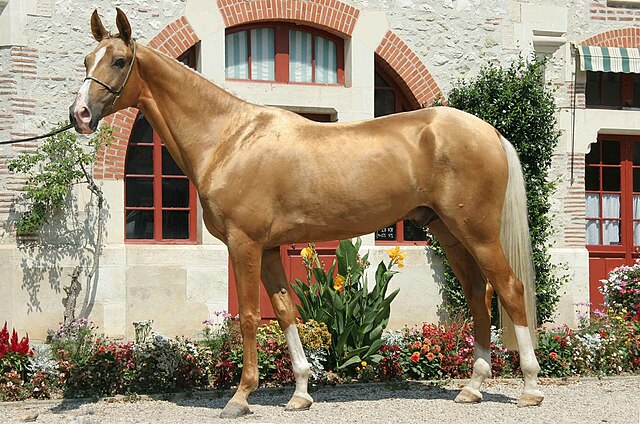
- Origin and Historical Significance: One of the oldest horse breeds, originating from present-day Turkmenistan, known for its endurance and speed.
- Physical and Temperamental Characteristics:
- Sleek coat that can appear metallic, slim but muscular build.
- Akhal Teke’s are known for endurance, intelligence, and agility.
- Military Advantages:
- Speed and endurance suited for long-distance raids and reconnaissance missions.
- Historical Battles/Events:
- Used by ancient nomadic tribes in Central Asia for raids and as cavalry horses in battles.
Berber (Barb)
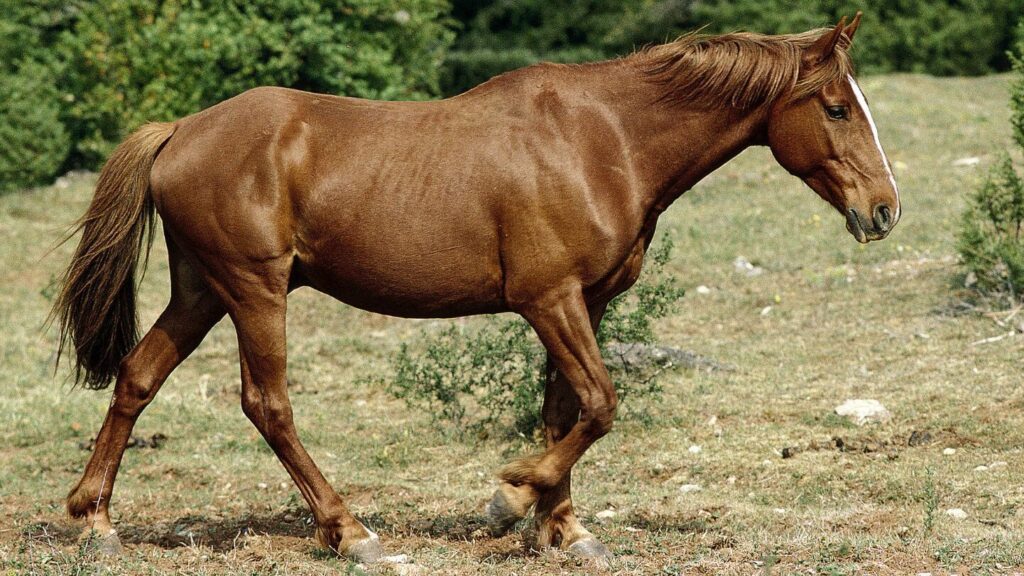
- Origin and Historical Significance: Originating from North Africa, known for its stamina and agility.
- Physical and Temperamental Characteristics:
- Barb horses are hardy and resilient, with a strong build.
- Excellent stamina and agility, capable of quick maneuvers.
- Military Advantages:
- Adaptability and endurance made them ideal for various military roles, including cavalry.
- Historical Battles/Events:
- Used extensively by the Moorish and North African cavalry in their conquests and battles across the Mediterranean.
Destrier

- Origin and Historical Significance: The preferred warhorse of medieval knights in Europe.
- Physical and Temperamental Characteristics:
- Large and strong, capable of carrying a knight in full armor.
- Bred for battle, showing courage and power.
- Military Advantages:
- Strength and size were ideal for shock combat in medieval warfare.
- Historical Battles/Events:
- Battle of Agincourt (1415), where heavily armored knights played a crucial role.
Friesian Horse
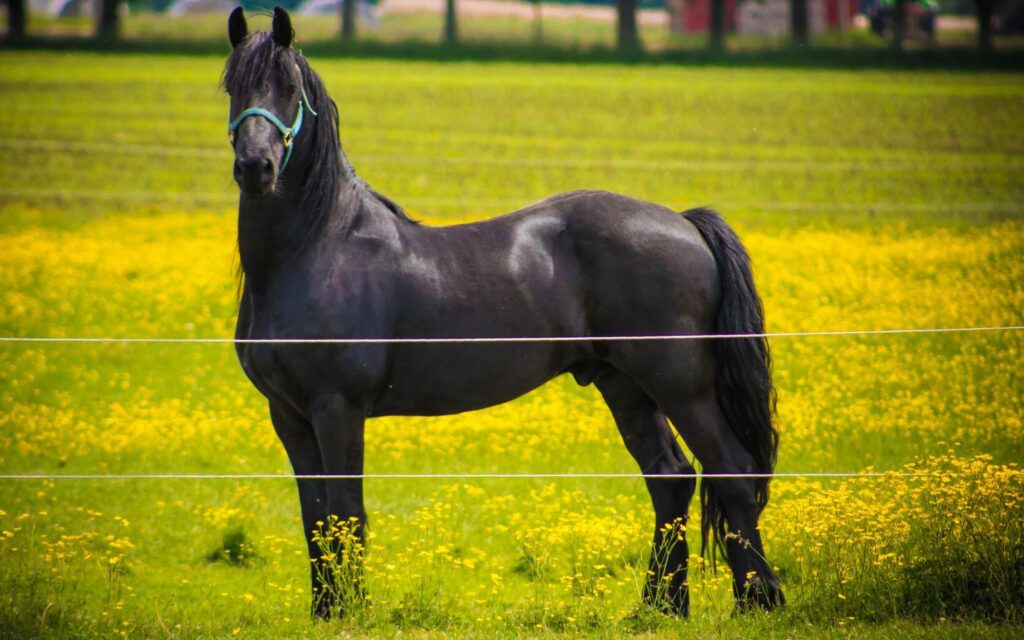
- Origin and Historical Significance: Originated from Friesland in the Netherlands, valued during the Middle Ages.
- Physical and Temperamental Characteristics:
- Friesian horses have a powerful build and majestic black coat.
- Known for strength and presence on the battlefield.
- Military Advantages:
- Used for its strength and ability to carry heavily armored knights.
- Historical Battles/Events:
- Crusades, where their presence and strength were highly valued.
Andalusian Horse
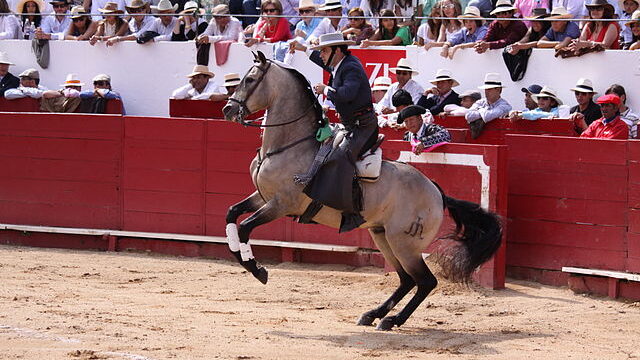
- Origin and Historical Significance: From the Iberian Peninsula, prominent during the Renaissance.
- Physical and Temperamental Characteristics:
- Athletic, intelligent, with a strong, compact body.
- Elegant gait, making it a favorite for its maneuverability and speed.
- Military Advantages:
- Andalusian’s agility and balance were prized for combat and ceremonial purposes.
- Historical Battles/Events:
- Used by European nobility in battles during the Renaissance period.
Percheron

- Origin and Historical Significance: Originating from the Huisne river valley in France, used in war before transitioning to peacetime roles.
- Physical and Temperamental Characteristics:
- Muscular build and good temperament.
- Valued for strength and endurance.
- Military Advantages:
- Strength and endurance made it suitable for pulling heavy war machines.
- Historical Battles/Events:
Mongolian Horse
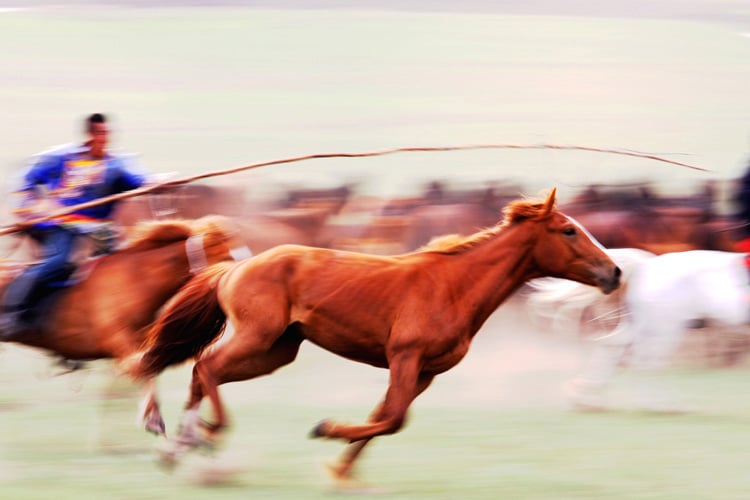
- Origin and Historical Significance: Essential to the success of Genghis Khan’s cavalry.
- Physical and Temperamental Characteristics:
- Small but sturdy, capable of withstanding extreme conditions.
- Known for incredible stamina and hardiness.
- Military Advantages:
- Stamina and hardiness were crucial across the vast expanses of the Mongol Empire.
- Historical Battles/Events:
- The Mongolian horse played a key role in the Mongol conquests, enabling rapid movement across large territories.
Shire Horse

- Origin and Historical Significance: Known for its strength and size, used in medieval England.
- Physical and Temperamental Characteristics:
- Immense strength and size, also known as the English Great Horse.
- Military Advantages:
- Historical Battles/Events:
- Valued for its ability to perform heavy labor post-medieval period.
Marwari

- Origin and Historical Significance: Originating from the Marwar region of India, known for their loyalty and bravery in battle.
- Physical and Temperamental Characteristics:
- Distinctive inward-turning ear tips, hardy and agile.
- Loyal and brave, with a high endurance level.
- Military Advantages:
- Agility and loyalty made them excellent cavalry horses in the Indian subcontinent.
- Historical Battles/Events:
- Used by Rajput warriors in numerous battles against invaders and in internal conflicts.

Comparative Analysis of War Horse Breeds
The war horse breeds, each with its unique attributes, played distinct roles in the tapestry of warfare throughout history. Let’s delve into a comparative analysis based on size, strength, agility, and endurance and understand how these traits influenced their roles in various warfare strategies.
Size: The Defining Factor
- Destrier and Shire: These breeds were the heavyweights of the medieval battlefield. The destrier, larger than most of its contemporaries, was ideal for carrying a heavily armored knight. Similarly, the Shire, known for its immense size and strength, was used for heavy cavalry and pulling significant loads.
- Arabian and Mongolian: In contrast, the Arabian and Mongolian horses were smaller, but their size contributed to their agility and endurance, making them suitable for rapid maneuvers and long-distance raids.

Strength: The Powerhouse of War
- Percheron and Friesian: The Percheron, with its muscular build, and the Friesian, known for its power and majestic presence, were both breeds that exemplified strength. They were capable of enduring the rigors of battle while carrying heavy armor or pulling large war machines.
- Andalusian and Marwari: These breeds, while not as physically imposing as the Percheron or Friesian, were still strong in their own right, capable of carrying armored soldiers, and known for their endurance in battle.
Agility: Quick and Graceful
- Arabian and Andalusian: The Arabian horse, with its light frame and quick movements, was perfect for swift attacks and retreats. The Andalusian, known for its agility and balance, was used for both combat and ceremonial purposes and valued for its ability to execute complex maneuvers.
- Holsteiner: Originally bred for war, the Holsteiner’s agility has now made it a top choice in show jumping and dressage.
Endurance: The Long-Distance Champions
- Mongolian Horse: Renowned for its incredible stamina, the Mongolian horse was a vital asset in the vast campaigns of the Mongol Empire, capable of traveling long distances without much rest.
- Arabian: Similarly, the Arabian horse, with its endurance and ability to thrive in harsh conditions, was ideal for long campaigns, particularly in desert terrains.
Coat Colors of War Horses
In the tapestry of war horse breeds, coat colors such as brown, bay, black, and chestnut were the most common and highly prized. The bay, with its rich reddish-brown hue and black mane, tail, and lower legs, was especially favored for its striking appearance and visibility on the battlefield.
These colors not only contributed to the majestic presence of war horses in parades and ceremonies but also had practical implications. For example, darker coats were preferred in the dense forests of Europe for their camouflage abilities, while lighter shades were valued in the deserts of the Middle East for their heat-reflective properties.
Warfare Strategies: Tailored for Battle
- Heavy Cavalry: The Destrier, Percheron, and Shire were central to the heavy cavalry tactics of medieval Europe, used for charging into enemy lines and breaking formations.
- Light Cavalry and Raids: The Arabian and Mongolian horses excelled in light cavalry roles, suitable for hit-and-run tactics, reconnaissance, and long-distance raids.
- Ceremonial and Tactical Maneuvers: The Andalusian and Marwari, with their combination of strength, agility, and elegance, were not only used in battle but also in parades and tactical displays.
Each war horse breed brought its unique set of characteristics to the battlefield, influencing the tactics and outcomes of warfare. From the heavy charges of the destrier to the enduring gallops of the Arabian, these breeds were not just participants in history; they were instrumental in shaping it.
What War Horse Breeds Did Famous Leaders Ride?
The bonds between legendary leaders and their war horses symbolize more than power and strategy; they reflect deep connections that have influenced the course of history. Here’s a glimpse into the lives of renowned figures and their equine companions:
Alexander the Great and Bucephalus

- Breed: Bucephalus is often described as having qualities that suggest he may have belonged to a breed similar to what we now know as the Akhal-Teke,
- Bond: A symbol of conquest and military genius, Bucephalus and Alexander shared a relationship founded on mutual trust and respect.
- Legacy: Alexander founded the city of Bucephala in honor of Bucephalus, marking their profound connection.
Genghis Khan and His Mongolian Horses

- Breed: Ghenghis Khan rode Mongolian horses
- Endurance: The resilience of Mongolian horses was pivotal in the Mongol Empire’s expansion, embodying the empire’s strength and reach.
- Contribution: These horses were essential for long-distance conquests, showcasing the strategic use of equine stamina in warfare.
Napoleon Bonaparte and Marengo

- Breed: Marengo was a small, grey Egyptian Arabian stallion.
- Symbol: Marengo, known for his incredible stamina, became a symbol of Napoleon’s military prowess.
- Influence: Marengo’s presence boosted troop morale, highlighting the psychological impact of war horses.
Charlemagne and His War Horses

- Breed: Mérens a small, light horse breed, thought to be ridden by Charlemagne.
- Strategy: Charlemagne’s use of robust war horses was key to his military campaigns, helping to expand and consolidate his empire.
- Preference: Charlemagne favored strong horses capable of carrying his heavily armored riders, reflecting the tactical needs of the era.
The legacy of these leaders and their war horses transcends mere tales of conquest, embodying the enduring spirit of partnership between humans and horses. Their stories remind us of the strategic, symbolic, and emotional roles horses have played throughout history.
The Role of War Horses in Modern Times
While the need for war horses has diminished with the advent of modern warfare, the legacy of these breeds continues. Today, many descendants of ancient war horse breeds excel in dressage, show jumping, and as beloved riding horses.
Their bloodlines, preserved by dedicated breeders, carry the history of their ancestors who charged through battlefields, pulled wagons and carts, and served kings and emperors across the world.
From Battlefield to Farm
- Adapting Roles: With the decline of cavalry units post-World War I, breeds like the Arabian and Percheron transitioned from combat to roles in companionship, agriculture, and transportation.
- Strength to Service: Their remarkable strength and endurance, once harnessed for battle, were repurposed for farming and pulling carriages, seamlessly integrating into civilian life.

An Arabian horse in a modern equestrian setting.
War Horses in Modern Sports
- Dressage and Show Jumping: Breeds such as the Andalusian and Holsteiner have found new arenas in dressage and show jumping, where their agility and grace shine.
- Endurance Riding: The Arabian horse, renowned for its stamina, has become a top choice for endurance riding, demonstrating its ability to cover long distances with ease.
Cultural and Ceremonial Roles
- Parades and Ceremonies: War horse breeds continue to captivate audiences in parades and ceremonial events, with their majestic presence and historical significance.
- Film and Media: Their striking appearance and storied past make breeds like the Arabian and Friesian sought-after stars in historical and fantasy genres.
Legacy in Breeding
- Influencing Modern Breeds: The genetic legacy of war horse breeds is evident in many modern horse breeds, including the Thoroughbred, showcasing the enduring impact of their lineage.
The transition of war horse breeds from the chaos of battlefields to the tranquility of modern equestrian life is a testament to their enduring legacy. These breeds have not only adapted to changing times but have also left an indelible mark on the equestrian world, influencing a wide range of activities and sports.
FAQs on War Horse Breeds
What breed of horse was a destrier?
The destrier, renowned for its use by knights during Medieval Times, was not a specific breed but rather a type of horse selected for its strength, size, and courage. These horses were the elite of the battlefield, often drawn from breeds that would now be considered heavy draft types or large war horses, akin to the modern-day Percheron or Shire.
What are the main types of horses used in warfare?
Historically, three main types of horses were used in warfare: destriers, coursers, and rounceys. Destriers were the heavy, powerful horses used by knights, coursers were known for their speed and endurance, and rounceys served as all-purpose horses for riding and light work.
What is a War Horse called?
A warhorse is often called a battle steed. They are typically large, strong horses with good stamina. The first War Horses were bred in England during the Middle Ages. The primary use of these horses was as cavalry mounts for heavily armored knights.
How were Coursers used in Medieval Times?
Coursers were highly valued during Medieval Times for their speed and agility. These horses were lighter and faster than destriers, making them ideal for tasks requiring quick maneuvering on the battlefield, such as carrying messages or scouting. Lighter cavalry units also used coursers for rapid attacks.
What makes Marwari horses unique among war horse breeds?
Marwari horses, originating from India, are distinguished by their unique inward-curving ear tips and remarkable endurance. These horses were bred for the harsh desert conditions of Rajasthan, making them incredibly resilient. In warfare, Marwari horses were prized by their riders for their loyalty and bravery, often seen in the thick of battle alongside Rajput warriors.
Were ponies used in warfare?
Yes, ponies were used in warfare, especially in regions where their small size and agility were advantageous, such as in the rugged terrains of Scotland. Ponies were often used for reconnaissance and as pack animals to carry supplies. Their hardiness and ability to navigate difficult landscapes made them invaluable in specific military contexts.

Conclusion: A Tribute to the War Horse
The war horse breeds, from the agile Arabian to the sturdy Shire, the graceful Andalusian, and the noble Friesian, have left an indelible mark on history. These breeds were not just participants in warfare; they were instrumental in shaping the course of civilizations.
As we look back on their contributions, from the early Middle Ages to the World Wars and beyond, we honor the war horse’s enduring spirit and the breeders who continue to preserve these magnificent animals’ legacy.
We invite you to share your experiences or any historical insights you have about these majestic war horse breeds. Whether it’s a story passed down through generations, a personal encounter with one of these breeds, or an admiration for their role in history, your contributions enrich our collective appreciation for these guardians of history.
Dive Deeper into Equine History
- Explore and Learn: Dive into the world of historical horse breeds. Whether through visiting museums, reading, or attending equestrian events, each step enriches your understanding of their impact on history.
Contribute to Preservation Efforts
- Support Preservation: Inspired to make a difference? Support organizations dedicated to the preservation and promotion of these breeds. Every act of volunteering, donation, or advocacy helps keep their legacy alive.

About the Author: Miles Henry
Lifelong Horseman | Racehorse Owner | Published Author
Miles Henry brings over 25 years of hands-on experience training and owning Thoroughbred racehorses. Raised with Quarter Horses and Appaloosas, he’s spent a lifetime learning from horses—on the track, in the barn, and in the field. Today, he runs a small but successful racing stable in Louisiana and shares real-world insights on HorseRacingSense.com, helping horse owners, fans, and bettors navigate the sport with confidence.
📚 Books: View Miles’s books on Amazon »
🎧 Podcast Guest: Animal Tales Ep. 32 |
YouTube Interview
📩 Newsletter: Sign up for racing tips and horse care advice »
🔗 Follow Miles:
Twitter |
Facebook |
YouTube


